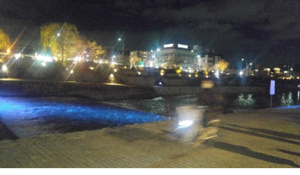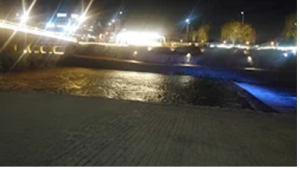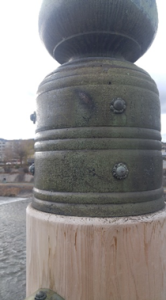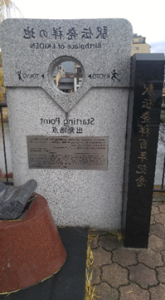From a demonstration experiment to create a nighttime landscape of Sanjo Ohashi Bridge, Thinking about the history of Sanjo Ohashi, it is inte limelight stage of history
Yoshie Doi
 |
 |
Taken from the south side of Sanjo Ohashi Bridge on January 16, 2024 at 6:30 p.m.
The next morning’s front page of the morning edition of the Kyoto Shimbun featured an image taken from the opposite direction.
 Sword Scar of Giboshi |
 Monument to the birthplace of Ekiden |
When the lights were turned on at 6:30 p.m. on January 16, 2024, the dark streets at night became brighter and I felt safer. The bright Kamogawa (Kamo river) stands out, the warm yellow lights gently turn on, and the sound and light of the flowing water creates a different scenery than usual.
Restoration work has been completed with new railings made from cypress in Keihoku and Kurama, Kyoto City. The protective fence features a hemp leaf pattern, an ancient Japanese pattern, creating an atmosphere befitting Kyoto.
There’s something I always say when I guide people around this area. In the Heian period, Sanjo-Dori was Sanjo-Oji in Heian-kyo, the central part of the capital lined with mansions of aristocrats. After that, Toyotomi Hideyoshi built Sanjo Ohashi Bridge in 1590, and it became the starting point of the Tokaido, and during the Edo period. was said to be the gateway to Kyoto. It was crowded with people welcoming and departing travelers.
It is not clear when this Sanjo Bridge was first built, but it seems that it was already built during the Muromachi period. In 1590, Toyotomi Hideyoshi transformed his vassal Masuda Nagamori into a magistrate. This fact is engraved on the Giboshi on the railing.
Additionally, the second Giboshi from the west on the south side has a sword scar. Legend has it that this scar was from the Ikedaya Incident on June 5, 1864. The following is what Isamu Kondo wrote in a letter at Yoimiya (Yoiyama) during the Gion Festival. It says, “More than 3,000 people from the shugo-shoku, Gosho-shidai, Hitotsubashi-dono, Hikone, Kashu, etc. will be on the trip.” In order to capture someone so many people went to the Sanjo or Shijo areas.
Isamu Kondo yelled out, “We will cut you down mercilessly when you are in charge,” and everyone retreated in fear,” Nagakura Shinpachi’s memoir “Roshi Bunkyu Hokoku Article” states. there is. In this memoir of Shinpachi Nagakura, only four people (Isamu Kondo, Souji Okita, Shinpachi Nagakura, and Heisuke Todo) rushed in, clashed with more than 20 patriots, killed several patriots, and captured the rest. It is written that. It is said that during the fierce battle, Toshizo Hijikata led a group to join forces, and the Shinsengumi did not suffer a single casualty.
This series of reports was conveyed to Emperor Komei by Matsudaira Katamori, and the “Ikedaya Incident Letter” states, “The Lord (Emperor Komei) is also pleased,” and the reward was 100 ryo from the imperial court and 500 ryo from the shogunate. A total of 600 ryo were given to the Shinsengumi.
In modern times, Sanjo Ohashi Bridge is the origin of the relay race, and is the starting point of the “Teito 50th Anniversary Exhibition – Tokaido Ekiden Walking Competition” from April 27, 1917. It was a three-day competition in which two teams, the East Army and the West Army, ran day and night over a distance of 516 km from Sanjo Ohashi Bridge to the main entrance of the Expo at Shinobazu Pond in Tokyo, divided into 23 sections. By the way, we started at the middle of Sanjo Ohashi Bridge.
Please be sure to take a stroll through Sanjo Ohashi Bridge, which is filled with the romance of history.
The end of document
Translated by Masami Otani
